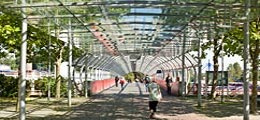Ultraviolet radiation (UV; 290-400 nm) comprises a relatively small fraction of solar radiation that reaches the Earth's surface. High-energy shorter wavelengths of solar UV (UVB; 290-315 nm) can potentially cause a range of adverse effects in plants, including disruption of the integrity and function of important macromolecules (DNA, proteins, and lipids), oxidative damage, changes in biochemistry, partial inhibition of photosynthesis, and growth reduction.1 Consequently, UV-B has traditionally been considered a stressor. However, recent studies have highlighted the regulatory properties of low, ecologically relevant doses of UV-B, which trigger significant changes in plant secondary metabolism.
Flavonoid glycosides and hydroxycinnamic acid derivatives are ubiquitously found in plants. They are antioxidants in planta and in humans and therefore interesting compounds for the production of functional food. Along the value chain from cultivar selection through pre- and postharvest, there is significant potential for the production of functional foods with elevated concentrations of flavonoid glycosides and hydroxycinnamic acid derivatives.
UV-B is one of the most effective abiotic factors to promote the biosynthesis of flavonoid glycosides and hydroxycinnamic acid derivatives with high antioxidant activity. It has been shown that chemical-structural properties of flavonoid glycosides and hydroxycinnamic acid derivatives strongly influence antioxidant activity.2 The new possibility of narrow-band application of UV-A and UV-B using LEDs provides an innovative approach to target enhancement of flavonoid glycosides and hydroxycinnamic acid derivatives with high antioxidant activity in food plants. As expected, the effect of UV-B compared to two wavelengths from the UV-A spectrum resulted in the highest induction of flavonoid glycosides, but not of hydroxycinnamic acid derivatives.3 With regard to the production of functional food, UV radiation is a particularly effective factor for influencing the phenolic profile in food plants.
- Bornman JF, Barnes PW, Robinson SA, Ballare CL, Flint SD, Caldwell MM. 2015. Solar ultraviolet radiation and ozone depletion-driven climate change: effects on terrestrial ecosystems. Photochem Photobiol Sci. 14:88–107. Epub 2014 Dec 2. eng. doi:10.1039/c4pp90034k.
- Neugart S, Fiol M, Schreiner M, Rohn S, Zrenner R, Kroh LW, Krumbein A. 2014. Interaction of moderate UV-B exposure and temperature on the formation of structurally different flavonol glycosides and hydroxycinnamic acid derivatives in Kale (Brassica oleracea var. sabellica). Journal of Agricultural and Food Chemistry. 62:4054–4062.
- Rechner O, Neugart S, Schreiner M, Wu S, Poehling HM. 2016. Different narrow-band light ranges alter plant secondary metabolism and plant defense response to aphids. Journal of Chemical Ecology. 42:989–1003. Epub 2016 Sep 4. eng. doi:10.1007/s10886-016-07552.



